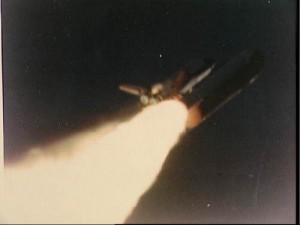
By Michael C. Jansen
One of my first experiences as a journeyman engineer paralleled Dickens’ A Tale of Two Cities. It was the best of times; it was the worst of times. Not quite six months after I came on-board permanently, the Shuttle Challenger exploded 73 seconds into mission 51L. Never have I experienced such a period of unified purpose and unhesitating professional cooperation across organizational boundaries as I did during our activities following this tragic event — not since has the subject of work been so grim.
As did many of my colleagues in Engineering, I doggedly threw myself into the piece of the accident investigation assigned to me. From the long-range photo and film footage, it was evident that a spurious plume had emanated from one of the solid rocket boosters (SRB), beginning roughly a minute into the flight. The visual data was backed by telemetered data that showed SRB nozzle gimbal angles changing to adjust for the slight loss of thrust in the affected booster. Judging by the ensuing glow, the plume had apparently impinged upon the External Tank (ET), fairly near its lower dome. From the telemetry data received up to the time of the explosion, the propulsion team ascertained that the ullage pressure in the ET’s hydrogen tank, upon which the plume seemed to be impinging, began to drop shortly after the glow was first visible in the film footage. This was an indication that the tank might have been breached, which spawned the theory that the liquid hydrogen therein ignited explosively, thereby triggering the Challenger’s destruction. Analysis was required to confirm or disprove this supposition, and, along with the above scanty information, I was given the task of supplying that proof.
Problem was, I had an extremely limited background in this (indeed, any) type of thermal analysis, which was considerably complicated by our gaps in knowledge. The spurious plume’s heat flux level was unknown. The exact location of the plume’s impingement point was unknown, which meant that the geometry of the affected portion of the tank wall could only be guessed at. The analysis had to account for the presence of a cryogenic liquid on the inside of the tank wall, which surely would begin to boil locally, with who knew what impact on the heat transfer away from the tank wall. And, most hindering, I knew absolutely nothing about heat transfer in boiling liquids.
As it turned out upon some quick research in our tech library, few people in the world did, and when it came to cryogenic boiling, the number of experts was in the single-digit category. Hmmm. But there, amid the handful of Russian names in the literature, was one American and his academic affiliation was with a local university! I couldn’t believe my good fortune! After obtaining permission to contact a non-NASA source as part of what we were supposed to treat as a secure investigation, I called this professor’s office immediately to set up an appointment to get some valuable guidance on how to approach my problem. He returned my call almost immediately and showed great interest in the situation: Was I investigating the Challenger accident? I told him we at NASA were under orders to treat all circumstances of the investigation as confidential, and that I could therefore not answer that (which, of course gave him his answer). He agreed immediately to a meeting.
If it walks like a duck and quacks like a duck, don’t try to tell me it’s a moose!
My first indication that I was in for a difficult meeting came when I walked into the professor’s office and was greeted not only by this world-class expert, but by one of his visiting Soviet colleagues as well. This being the pre-detente era, when the Soviets were actively “borrowing” our technology to develop their own Space Shuttle system, and considering the confidential nature of the investigation I was a part of, the man’s presence made me quite uncomfortable. The professor, perhaps instinctively reacting to my obvious youth and his role as learned advisor, immediately justified his colleague’s inclusion in our meeting as a means of getting another expert to consider the technical problem in order to bring this serious situation to a rapid conclusion. Certainly I had no objections, right? Fresh from college, I allowed myself to fall into the professor-student relationship and acquiesced.
He wasted no time in resuming his questioning: This was part of the Challenger investigation, right? My attempts to deflect the question only strengthened his conviction that he was correct. His excitement was palpable: So, what are the details of the problem? I explained that I was interested in calculating the heat transfer away from an aluminum wall that had a heat source on one side and liquid hyrdrogen on the other. What type of aluminum? I didn’t know, but could find out. What local wall thickness? Not sure, the heat source impingement point was only grossly estimable, and the local geometry changes dramatically in that region. What was the heat flux to the wall? Don’t know; the engineers estimating that hadn’t yet released any numbers. What is the inner wall surface roughness? Don’t know; I could perhaps estimate it based on manufacturing specifications. Size and distribution of bubbles coming off the inner wall? How would I know that? Number and depth of nucleation sites? Huh??
What do you know?
Well, not much — that’s why I came to you for help on how to approach this problem.
The professor, obviously disgusted, rattled off the myriad variables that estimation of the heat transfer coefficient depended on, all of which were important, and none of which I seemed to know. I asked whether the general approach couldn’t be outlined, with best guesses and available data to be inserted later to arrive at a good ballpark number? He scoffed, smirked at his Russian counterpart, and told me the problem could not be solved without knowing the variables he had laid out for me. Then the professor, in one of the more open displays of condescension I’ve witnessed, told me in essence to come back again when I knew what the heck I was talking about, or send someone else more experienced who might have a better handle on the problem.
I fumed during the entire 45-minute drive back to my office.
Seat-of-the-pants engineering…
Bruised ego notwithstanding, I still had a problem to solve. I returned to the reference books I had borrowed from the library and reevaluated the information to be gleaned therefrom. The problem that had caused me to seek assistance to begin with was that no single boiling point curve (in essence, a representation of how quickly heat could be carried away from a surface by a boiling liquid) existed for cryogens. Myriad empirical formula existed, each typically valid for only a narrow temperature range, specific surface material, surface finish, etc.; all of them sported the alphabet soup of variables for which I had no estimates.
Well, if there was no single cryogenic boiling curve to suit my situation, I’d piece together one of my own. Several sheets of log paper later, I had in front of me an approximation of a hyrdrogen boiling curve spanning the gamut of temperature differences ever tested in the history of cryogenic research. Considering the incredible scatter in the empirical data I had synthesized to form my curve, I had no idea whatsoever if I was in the same universe with reality, but I had my start-point. I just needed to test it, but how? The team working on an estimate of the plume-induced heat-flux to the ET weren’t quite ready with a heating range, and the kind of testing I had in mind wouldn’t be safe to do with liquid hydrogen anyway. Ah, but of course: inert liquid nitrogen! I quickly repeated my kludgework, this time to approximate nitrogen’s boiling curve.
I consulted a friend of mine in the thermal analysis area and together we designed a test setup that included a simple open-top aluminum box (of the same aluminum as the ET — I had researched the materials). We had the techs build and instrument several such tanks with thermocouples radiating from a central target zone on one side. We then set up a calorimeter-instrumented target and measured the heat flux from a blow torch at various distances along a centerline perpendicular to the calorimeter’s face. My friend then developed a simple two-dimensional conduction model of the tank’s face and made predictions, using my nitrogen boiling curve, of the time it would take to melt the tank’s wall at the various heat flux levels for which we had blow torch distance data. Following a test plan scribbled on a sheet from an engineering pad, we had the techs fill the first tank with liquid nitrogen and position the blow torch at the closest (highest incident heating) position. Then, with a roomful of bemused older techs watching and our cauldron bubbling over with nitrogen fog, I signaled one of them to fire up the torch, the signal for my friend to click the stopwatch.
“Time!” I yelled at the first sign of nitrogen pouring from the new penetration into the overflow basin.
And the answer is…
“8.6 seconds!” answered my friend, even as the tech shut down the torch.
“What was the prediction?” Dared I hope? The actual time had sounded fairly familiar…
After the moment it took my friend to search our handwritten matrix, the techs’ grins changed purpose and broadened.
“8.8 seconds!”
We repeated the process several times for various torch distances; in each case the experimental burn-through time matched our prediction to within ten percent. Later plots of the thermocouple data revealed that we had also matched the wall temperature time-histories very well, not just the time needed to reach the aluminum’s melting point. Having validated my nitrogen boiling curve and my friend’s two-dimensional wall model, we set our sights on the real problem at hand.
Working from the plume team’s estimates on where the jet was impinging on the E T, my friend developed two- and three-dimensional thermal conduction models of the local ET wall geometry. Since the models’ thermal responses turned out to be only negligibly different, we felt that the validation provided by our test results could be extended to our three-dimensional approach as well. From that point onward it was a mere matter of plugging in my hyrdrogen boiling curve, making a burn-through prediction based on the plume team’s estimated time-varying incident heating rates, and comparing our prediction against the flight data.
Our prediction matched within four percent.
Epilogue
The hypothesis that the ET’s liquid hyrdrogen tank initiated the Challenger’s explosion turned out to be false. (The plume was determined to have melted the booster’s aft attach strut, which allowed the booster to rotate about its forward strut and puncture the ET’s liquid oxygen tank, which resulted in the initial explosion.) Nevertheless, the plume’s penetration of the ET’s aft dome was confirmed by our analysis, which added to our understanding of the events that transpired during this tragic disaster.
I took away from the experience a great appreciation for the ability of a group of focused, committed people to accomplish seemingly miraculous results within extremely short timeframes, with a minimum of information to go on. I also acquired a healthy skepticism for the infallibility of theoretical experts, coupled with new confidence in the ability of common-sense engineering to produce usable results even in the absence of all the data one would normally like to have. However, don’t take this to mean that I think engineers are better equipped than theoretical experts to address such problems as the one described in my story here. “Experts” can seldom give useful answers to unexpected questions without an opportunity for study, and it is rare that they will volunteer to put aside their own work to study “your” problem. Unless we are willing to fund them for an extended period, their advice must be used judiciously, and primarily in a review capacity.
Still, in a pinch the back of the envelope can work quite well.
Lesson
- Don’t be buffaloed by experts and elites. Experts often possess more data than judgment. Elites can become so inbred that they produce hemophiliacs who bleed to death as soon as they are nicked by the real world.
Question:
In situations like the one in this story, is it better to try solving a problem without an expert’s help, or is it better to try to collect more data and visit the expert one more time?
About the Author
 |
Michael C. Jansen was recently named the Technical Assistant to the Assistant Business Manager for Assessments within the International Space Station Program’s Business Management Office. |









